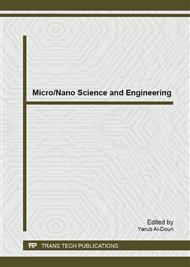p.548
p.553
p.559
p.564
p.570
p.575
p.580
p.585
p.590
Effect of Reflective Platinum Film on the Performance of Flexible Dye Solar Cell (DSC)
Abstract:
Robust and flexible dye solar cell (DSC) made up of nanocrystalline TiO2 encapsulated in polyethylene naphthalate (PEN) substrate will be able to fulfill the demand for indoor power applications as it has lower energy and manufacturing cost, produces electricity in low light conditions even under artificial light. The fabrication using PEN substrate has the advantage of scalability and compatible with the roll to roll manufacturing method. This paper reports the study on the effect of platinum film reflectance on the counter electrode to the DSC performance and efficiency. The reflective counter electrode uses the commercially available Pt/Ti PEN film with 100% reflectance properties. The transparent counter electrode with 20.9% reflectance is prepared using pre-treated indium doped tin oxide (ITO). The platinum film is sintered at 170°C followed by direct heat of 150°C to achieve a good bonding between the ITO and the deposited platinum film. Both cells uses TiO2 coated ITO PEN as the working electrode. The DSC test cell with reflective counter electrode increases the cell efficiency compared to the non-reflective counter electrode as there is a higher light spectrum response on the reflective DSC cell.
Info:
Periodical:
Pages:
570-574
Citation:
Online since:
April 2014
Authors:
Keywords:
Price:
Сopyright:
© 2014 Trans Tech Publications Ltd. All Rights Reserved
Share:
Citation:



